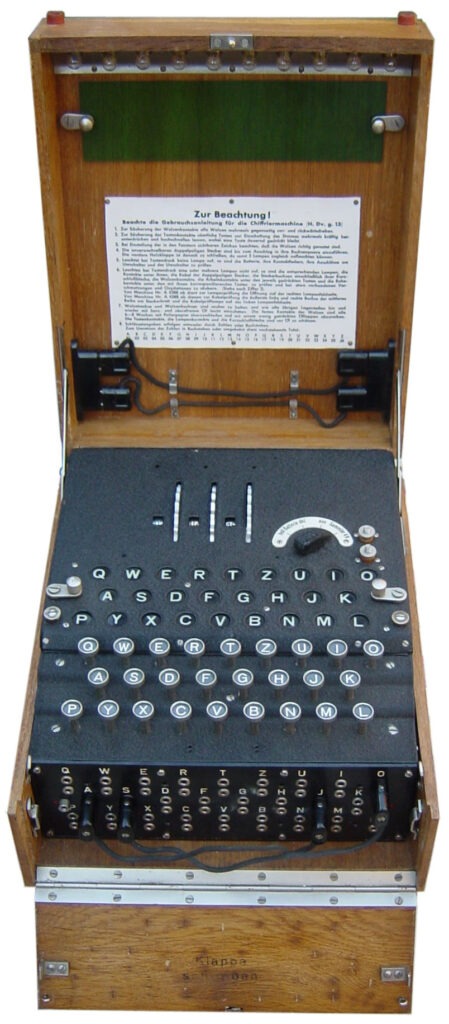The Enigma machine was first developed in 1918 by Dr Arthur Scherbius, in the hope of interesting banks in secure communications. In 1923 he set up his Chiffriermaschinen Aktiengesellschaft (Cipher Machines Corporation) in Berlin but it was the machine’s military application that was to prove decisive. Within three years the German navy was producing its own version, followed in 1928 by the army and in 1933 by the air force.

The Enigma is an electro-mechanical encrption machine based on alphabetic substitution – i.e. one letter is substituted for another. Enigma allowed an operator to type in a message, which was then scrambled by the machine based on certain settings. The receiver needed to know the exact settings of the transmitting machine in order to reconstitute the coded text.
The key to breaking any code is spotting a pattern. The strength of the Enigma was that it changed the pattern after each individual letter was inputed. It has been estimated that the machine had one hundred and fifty-nine million million million possible combinations.
Principles of operation
Enigma Machine showing the plugboard at the front, the input keyboard, the glass windows where the encrypted letter would light up and, above them, the three rotors in their slots
A message to be enciphered was input from a keyboard which had a QWERTZUIO layout. The signal left the keyboard and passed through a plugboard (known as a Steckerboard) where, if the plugboard socket contained a connector, its identity was switched to a different letter. If the particular socket did not contain a plug, the identity of the input character was unchanged. The plugboard substitution was reciprocal – i.e. if A was switched to Z, then Z was switched to A, a weakness that was to be exploited by Allied cryptanalysts.
From the plugboard the signal then passed to the entry stator which passed it to the first of a series of three rotors. Each of these had twenty-six contacts on each of its faces, cross-wired in a random fashion so that the identity of an incoming character was changed three times as it passed through the three wheels. With each keystroke the extreme right-hand wheel moved one position before encipherment took place. Additionally, once during a complete revolution of each wheel, the wheel to its immediate left stepped forward one place.
After passing through all three wheels the signal reached the reflector which performed two functions – it changed the signal’s identity once again and also sent it back, in the reverse direction, through the three wheels to the entry stator. From here it passed back to the plugboard and then to the lampboard where a lamp corresponding to the now enciphered character was illuminated.
Because of the reflector’s function in the encipherment process, no plaintext character could ever encipher to itself – another weakness in the system that was exploited to great effect by the Allied cryptanalysts.
Procedure for operating the machine
Enigma was set up according to daily instructions by adjusting the following parameters (this has been simplified to exclude the more complex Kriegmarine machines):
1. Three wheels were selected from a set of five in the case of the Army and Air Force machines and from a set of eight in the case of the Naval machines. The daily instructions would also specify the reflector.
2. After setting the index ring on each rotor, the three wheels were arranged on the machine’s spindle in the order prescribed in the daily instructions for machine initialization.
3. The plugboard was then set up according to the same instructions. Normally, ten sets of plugs were used leaving six letters ‘self-steckered’.
4. The internal lid of the Enigma was closed and the wheels set to the initial position.
Breaking the code
Enigma was originally broken by the Poles in 1932, when they intercepted a machine destined for the German Embassy in Warsaw and were able to reconstruct it.
At that time, the settings were only changed every few months. With the advent of war, however, the Nazis took to changing the settings daily, effectively shutting the Poles out. They were nevertheless able to pass on their knowledge to British and French codebreakers, led by Alan Turing at Bletchly Park. This knowledge enabled Turing’s team to make critical progress in working out the order in which the keys were attached to the electrical circuits, a task that would have been impossible without an Enigma machine in front of them.
Armed with this knowledge, the codebreakers were then able to exploit a chink in Enigma’s armour. A fundamental design flaw meant that no letter could ever be encrypted as itself; an A in the original message, for example, could never appear as an A in the code. This gave the codebreakers a toehold. Errors in messages sent by tired, stressed or lazy German operators also gave clues. The first Enigma message was deciphered in January 1940.
A team of between ten and twelve thousand people was eventually involved in the code-breaking effort, many of them women. As well as developing a series of machines, or bombes, to help reduce the odds in breaking the ever-changing keys, the team also built a machine known as Colussus, now viewed as probably the world’s first computer.
The ability of Allied forces to read enemy communications, especially with regards to protecting Atlantic shipping and in planning and executing the D-Day landings, is viewed as one of the key turning points of the war.
Click here for links to other Enigma sites which provide a more detailed account than that contained here.
In The Black Sun, an Enigma machine is stolen from the collection found at the National Crytologic Museum in Fort Meade, Maryland. This machine is then used by Tom (although operating instructions have been simplified) to decode a message.




